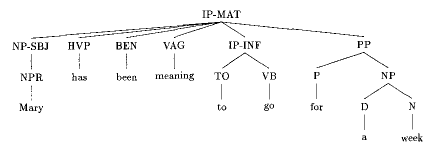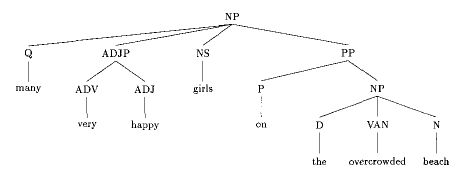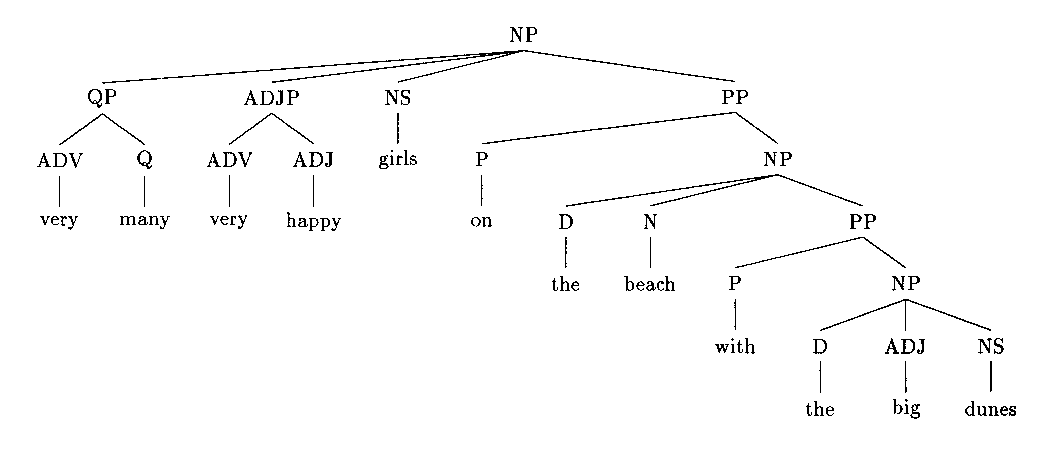Introduction to Syntactic Annotation
-
- General parsing principles
- Phrasal syntax
- Table of contents
The PPCME2 parsing scheme uses a limited tree representation in the
form of labelled parentheses. All open parentheses have an associated
label, either a phrase label (NP, ADJP, etc.) or a word label (N,
ADJ, etc.), representing nodes in a tree. Word-level labels are
provided for every word, but phrasal labels are not included in every
case in which a fully labelled tree would require them. Intermediate
levels of structure (N', ADJ', etc.) are never represented explicitly.
Thus the trees are quite flat.
This approach has no theoretical import, but rather was adopted purely for
practical reasons. Some phrases were omitted because their boundaries are
too difficult to define. This is the case for VP, which, especially in
Early Middle English where the order of the verb and its complements is
still in flux (at least on the surface), cannot easily be included. Other
phrases, such as DP, were omitted because in our opinion, the cost of
including them outweighs their usefulness. Intermediate levels of
structure are omitted for both reasons. In no case should the lack of any
particular phrase label be taken as implying that we do or do not believe
that Middle English syntax failed to include such a phrase. The trees are
simply underspecified.
This introduction to our parsing scheme includes only a basic outline of
the general principles we followed in parsing and details on the most
common structures. All examples in the present document are made up and
given in Modern English so as to be maximally accessible. For complete
documentation of the system with Middle English examples, see the full documentation.
Full lists of the labels used in the PPCME2 are included in the last
section of the main table of contents.
General parsing principles
-
PPCME structure is very flat. Most nodes are multiply branching. A typical
PPCME parse in tree form looks like this:

Note that:
- IP (in this case, IP-MAT, a matrix IP)
immediately dominates all verbs and sentence level constituents; that is,
there are no intemediate I' levels or a VP.
(IP-MAT (NP-SBJ (NPR Mary))
(HVP has)
(BEN been)
(VAG meaning)
(IP-INF (TO to)
(VB go))
(PP (P for)
(NP (D a) (N week))))
-
In addition to verbs, a small number of other word-level constituents are
immediately dominated by IP. These are: particles (RP), sentential
conjunctions (CONJ) and single-word interjections (INTJ)
(IP-MAT (CONJ And) <--- sentential conjunction
(NP-SBJ (NPR Mary))
(VBD looked)
(RP up) <--- particle
(NP-OB1 (NP-GEN (NPR Jane) ($ 's))
(N number)))
(IP-MAT-SPE (INTJ Alas) <--- single-word interjection
(IP-MAT-PRN (VBD cried)
(NP-SBJ (NPR Mary)))
(NP-SBJ (PRO I))
(HVP have)
(VBD lost)
(NP-OB1 (PRO$ my) (NS glasses)))
-
Within phrasal constituents, the phrasal node immediately dominates the
head; there are no intermediate levels of structure (N', ADJ' etc.).
(NP (D the ) (N girl))
(PP (P in)
(NP (D the) (N spring)))
(ADJP (ADV very) (ADJ big))
-
Pre-head modifiers do not project phrasal nodes when they consist of a
single word, but do when they are multi-word. Because of the lack of
intermediate levels of structure, all modifiers appear as sisters of the
head.
(NP (D a) (ADJ big) (N cat))
(NP (D a)
(ADJP (ADV very) (ADJ big))
(N cat))
- Post-head constituents project phrasal nodes in all cases. Like
pre-head modifiers, they are sisters to the head.
(IP-MAT (PP (P From)
(ADVP (ADV above)))
(MD shall)
(VB come)
(NP-SBJ (D +te) (N judge)
(ADJP (ADJ fierce) (CONJ and) (ADJ angry)))
(E_S ;))
(IP-MAT (NP-SBJ (PRO He))
(ADVP-TMP (ADV never))
(VBD found)
(NP-OB1 (D a) (N woman)
(ADJP (ADJ good))))
(IP-MAT (NP-SBJ (D The) (N king))
(VBD gave)
(NP-OB2 (PRO him))
(NP-OB1 (D an) (N island)
(RRC (VAN forsaken)))) <--- RRC = reduced relative clause
(IP-MAT (NP-SBJ (PRO$ Our) (N life)
(ADVP-LOC (ADV here)))
(BEP is)
(ADJP (ADV very) (ADJ comfortable)))
(IP-MAT (NP-SBJ (PRO She))
(VBD came)
(NP-TMP (D the) (ADJ fifth) (N day)
(ADVP-TMP (ADV+WARD afterward))))
- The PPCME labels for both form and function. In general, the basic
label indicates the form of the constituent (NP, PP, ADJP, etc.), while
additional labels (separated by a hyphen) indicate function (NP-SBJ =
subject, ADVP-TMP = temporal adverb, CP-REL = relative clause, etc.). Not
all constituents are marked for function; in most cases there is at most
one additional label, but there may be more (IP-INF-PRP = purpose
infinitive, IP-IMP-SPE = direct speech imperative, etc.).
-
Among sentence level constituents (i.e., all phrases immediately dominated
by IP), function is marked on all noun phrases (NP-SBJ = SUBJECT, NP-MSR =
MEASURE NP, etc.). Bare NPs are either complements of a non-verbal head
(e.g., a preposition), or part of a conjunction structure (see Section
CONJUNCTION).
(IP-MAT (NP-TMP (N Yesterday))
(NP-SBJ (NPR Mary))
(VBD told)
(NP-OB2 (NPR Jane))
(CP-THT (C that)
(IP-SUB (NP-SBJ (PRO she))
(VBD studied)
(NP-MSR (QP (ADVR too) (Q much)))
(PP (P during)
(NP (D the) (N+N weekend))))))
-
Argument and adjunct PPs are not distinguished, nor are any PPs marked for
function.
(IP-MAT (NP-SBJ (NPR Mary))
(VBD put)
(NP-OB1 (D the) (N book))
(PP (P on)
(NP (D the) (N table)))
(PP (P on)
(NP (NPR Saturday))))
-
Only locative, temporal and directional adverbs are marked for function;
others are unmarked.
(IP-MAT (NP-SBJ (NPR Mary))
(ADVP (ADV happily))
(VBD put)
(NP-OB1 (D the) (N book))
(ADVP-LOC (ADV there))
(ADVP-TMP (ADV+WARD afterward)))
-
All clauses are labelled by type. Matrix clauses are labelled IP-MAT; they
may be further characterized as direct speech (IP-MAT-SPE) or
parentheticals (IP-MAT-PRN) Other IP clauses have their own labels,
such as IP-IMP, imperative, IP-SMC, small clause, IP-INF, infinitive, etc. All CPs also have extended labels to indicate type:
CP-THT, that clause, CP-ADV, adverbial clause, etc.
(IP-MAT (NP-SBJ (NPR Mary))
(VBD forgot)
(IP-INF (TO to)
(VB tell)
(NP-OB2 (NPR Jane))
(CP-THT (C that)
(IP-SUB (NP-SBJ (PRO she))
(MD should)
(VB buy)
(NP-OB1 (N milk))))))
-
In cases where the attachment level of constituents is ambiguous or
difficult to determine, the default is always to attach high, rather than
to embed.
(IP-MAT (NP-SBJ (NPR Mary))
(VBD saw)
(NP-OB1 (D the) (N man))
(PP (P with)
(NP (D the) (N telescope))))
Phrasal syntax
The internal syntax of all phrasal categories (excluding IP and CP) is
fundamentally similar.
- The phrasal node (NP, PP, ADJP, etc.) immediately dominates the head
category (N, P, ADJ, etc.); that is, there are no intermediate bar-levels
indicated.
- With two exceptions, heads always project a phrasal node. First,
certain heads, such as D (determiner), RP (particle) and all verbs, never
project a phrase. Second, single-word pre-head modifiers do not project a
phrasal node when that node is predictable on the basis of the head within
the PPCME2 schema.
- Complements and post-head modifiers always project a phrasal node,
whether they consist of a single word or not.
Thus in the PPCME2 schema, both modifiers and complements are sisters of
the head.

(XP (Y single_word_modifier) (X head)
(ZP complement_or_post_head_modifier))
(XP (W single_word_modifier) (Y single_word_modifier) (X head)
(ZP complement_or_post_head_modifier))
(XP (YP multi_word_modifier)
(X head)
(ZP complement_or_post_head_modifier))
(NP (D the) (NS girls)
(PP (P on)
(NP (D the) (N beach))))
(NP (Q many) (ADJ happy) (NS girls)
(PP (P on)
(NP (D the) (VAN overcrowded) (N beach))))
(NP (ADJP (ADJ happy) (CONJ and) (VAN excited))
(NS girls))
(NP (Q many)
(ADJP (ADV very) (ADJ happy))
(NS girls)
(PP (P on)
(NP (D the) (VAN overcrowded) (N beach))))
(NP (QP (ADV very) (Q many))
(ADJP (ADV very) (ADJ happy))
(NS girls)
(PP (P on)
(NP (D the) (N beach)
(PP (P with)
(NP (D the) (ADJ big) (NS dunes))))))


Other phrases have the same structure as NPs.
(ADJP (ADV very) (ADJ happy))
(ADJP (ADJ full)
(PP (P of)
(NP (N water))))
(PP (ADV especially)
(P on)
(NP (NPRS Saturdays)))
(PP (ADV right)
(P up)
(NP (D the) (N street)))
(ADVP (ADV very) (ADV slowly))
- In general the head of a phrase will be overt and match the category
of the phrase level. In certian cases, however, there is no matching
head. In some cases this is because the head is actually empty (by elision,
etc.), which we do not indicate; in other cases, it may be an artifact of
the PPCME schema in which some words receive a more specific label than
simply N, ADJ, etc. For example, pronouns are labelled
PRO, but act as heads of NPs. Most instances of the word "one" are
labelled ONE and in some cases this word may be the head of the
constituent. Thus, the lack of a word-level constituent that matches the
phrase in category indicates either (1) the head has been elided; or (2)
the head has a more specific label than its general category label.
Most cases of the latter are found in NPs and ADJPs. The most common types
of correspondences are the following:
- nominal elements not labelled N (NS, etc.)
PRO, EX, MAN, OTHERS, ?PRO$, ?ONE, ?OTHER, ?D, ?Q, (QR, etc.)
- adjectival elements not labelled ADJ (ADJS, etc.)
VAN, VAG, (HAN, HAG, etc.), SUCH, QR, ?ONE, ?OTHER
As indicated by the question marked elements in the above lists, it is not
always clear in some cases whether the word is the head or the head is
elided. It is mainly for this reason that we do not make this distinction
for these words.
The most common elision case is of the NPs containing only an adjective
or, more commonly, a determiner and adjective.
(IP-MAT (IP-MAT-1 (NP-SBJ (NPR Mary))
(VBD gave)
(NP-OB2 (NPR Jane))
(NP-OB1 (D a) (ADJ red) (N ribbon)))
(CONJP (CONJ and)
(IP-MAT=1 (NP-OB2 (NPR Lucy))
(NP-OB1 (D a) (ADJ blue))))) <--- elided head noun